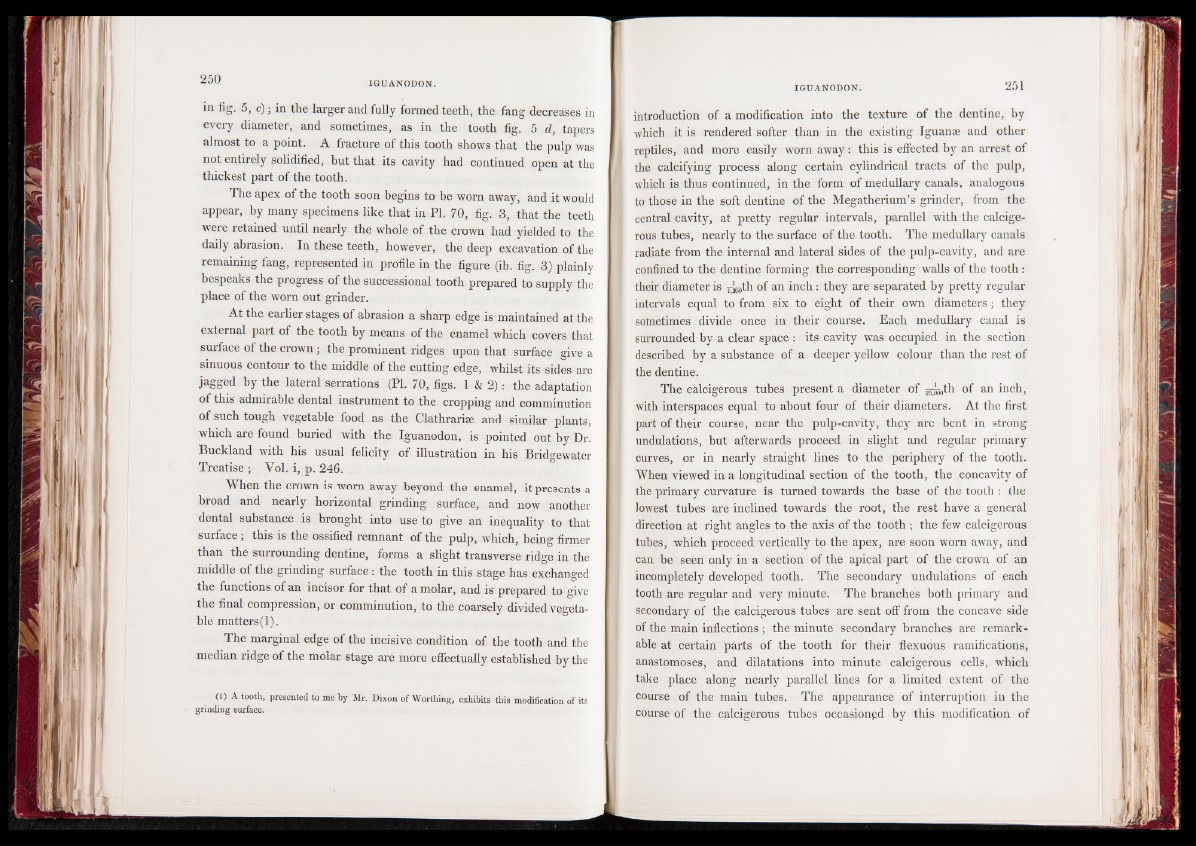
in fig. 5, c); in the larger and fully formed teeth, the fang decreases in
every diameter, and sometimes, as in the tooth fig. 5 d, tapers
almost to a point. A fracture of this tooth shows that the pulp was
not entirely solidified, but that its cavity had continued open at the
thickest part of the tooth.
The apex of the tooth soon begins to be worn away, and it would
appear, by many specimens like that in PI. 70, fig. 3, that the teeth
were retained until nearly the whole of the crown had yielded to the
daily abrasion. In these teeth, however, the deep excavation of the
remaining fang, represented in profile in the figure (ib. fig. 3) plainly
bespeaks the progress of the successional tooth prepared to supply the
place of the worn out grinder.
At the earlier stages of abrasion a sharp edge is maintained at the
external part of the tooth by means of the enamel which covers that
surface of the crown; the prominent ridges upon that surface give a
sinuous contour to the middle of the cutting edge, whilst its sides are
jagged by the lateral serrations (PL 70, figs. 1 & 2): the adaptation
of this admirable dental instrument to the cropping and comminution
of such tough vegetable food as the ClathrariEe and similar plants,
which are found buried with the Iguanodon, is pointed out by Dr.
Buckland with his usual felicity of illustration in his Bridgewater
Treatise ; Vol. i, p. 246.
When the crown is worn away beyond the enamel, it presents a
broad and nearly horizontal grinding surface, and now another
dental substance is brought into use to give an inequality to that
surface; this is the ossified remnant of the pulp, which, being firmer
than the surrounding dentine, forms a slight transverse ridge in the
middle of the grinding surface : the tooth in this stage has exchanged
the functions of an incisor for that of a molar, and is prepared to give
the final compression, or comminution, to the coarsely divided vegetable
matters (1).
The marginal edge of the incisive condition of the tooth and the
median ridge of the molar stage are more effectually established by the 1
(1) A tooth, presented to me by Mr. Dixon of Worthing, exhibits this modification of its
grinding surface.
introduction of a modification into the texture of the dentine, by
which it is rendered softer than in the existing Iguanse and other
reptiles, and more easily worn away: this is effected by an arrest of
the calcifying process along certain cylindrical tracts of the pulp,
which is thus continued, in the form of medullary canals, analogous
to those in the soft dentine of the Megatherium’s grinder, from the
central cavity, at pretty regular intervals, parallel with the calcige-
rous tubes, nearly to the surface of the tooth. The medullary canals
radiate from the internal and lateral sides of the pulp-cavity, and are
confined to the dentine forming the corresponding walls of the tooth :
their diameter is y^th of an inch: they are separated by pretty regular
intervals equal to from six to eight of their own diameters ; they
sometimes divide once in their course. Each medullary canal is
surrounded by a clear space : its cavity was occupied in the section
described by a substance of a deeper yellow colour than the rest of
the dentine.
The calcigerous tubes present a diameter of ^ „th of an inch,
with interspaces equal to about four of their diameters. At the first
part of their course, near the pulp-cavity, they are bent in strong
undulations, but afterwards proceed in slight and regular primary
curves, or in nearly straight lines to the periphery of the tooth.
When viewed in a longitudinal section of the tooth, the concavity of
the primary curvature is turned towards the base of the tooth : the
lowest tubes are inclined towards the root, the rest have a general
direction at right angles to the axis of the tooth ; the few calcigerous
tubes, which proceed vertically to the apex, are soon worn away, and
can be seen only in a section of the apical part of the crown of an
incompletely developed tooth. The secondary undulations of each
tooth are regular and very minute. The branches both primary and
secondary of the calcigerous tubes are sent off from the concave side
of the main inflections; the minute secondary branches are remarkable
at certain parts of the tooth for their flexuous ramifications,
anastomoses, and dilatations into minute calcigerous cells, which
take place along nearly parallel lines for a limited extent of the
course of the main tubes. The appearance of interruption in the
course of the calcigerous tubes occasioned by this modification of